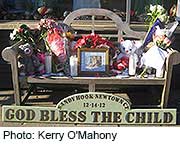
SUNDAY, Aug. 23, 2015 (HealthDay News) — The United States comprises only 5 percent of the global population, but it accounts for 31 percent of public mass shooters worldwide, a new study shows.
The analysis of data, from hundreds of countries between 1966 and 2012, also shows a link between a nation’s gun ownership levels and its number of public mass shootings, according to study author Adam Lankford, an associate professor of criminal justice at the University of Alabama.
He defined public mass shootings as incidents that resulted in the deaths of more than four people, did not occur in homes, were not gang-related and were not hostage situations or robberies.
The findings were to be presented Sunday at the annual meeting of the American Sociological Association (ASA), in Chicago. Research presented at meetings should be viewed as preliminary until published in a peer-reviewed journal.
“The United States, Yemen, Switzerland, Finland and Serbia are ranked as the top five countries in firearms owned per capita, according to the 2007 Small Arms Survey, and my study found that all five are ranked in the top 15 countries in public mass shooters per capita. That is not a coincidence,” Lankford said in an ASA news release.
“Until now, everyone was simply speculating about the relationship between firearms and public mass shootings. My study provides empirical evidence of a positive association between the two,” Lankford said.
However, the study did not prove there was a causal relationship between the two.
Lankford also examined differences between public mass shootings in the United States and in other countries.
Public mass shooters in other nations were 3.6 times less likely to have used multiple weapons — typically more than one gun, but occasionally a gun and another type of weapon — than those in the United States, where more than half of shooters used at least two weapons.
“Given the fact that the United States has over 200 million more firearms in circulation than any other country, it’s not surprising that our public mass shooters would be more likely to arm themselves with multiple weapons than foreign offenders,” Lankford said.
“I was surprised, however, that the average number of victims killed by each shooter was actually higher in other countries [8.8 victims] than it was in the United States [6.9 victims] because so many horrific attacks have occurred here,” he added.
This may be because mass public shootings are so common in the United States that American police have more experience and are better trained to deal quickly with such incidents, which reduces the number of victims in a given incident, Lankford suggested.
He also found that U.S. public mass shooters were more likely to strike in schools, factories/warehouses and office buildings than those in other countries, who were much more likely to attack military targets, such as bases, barracks and checkpoints.
Lankford offered Australia as an example of what stronger gun control laws can do.
“From 1987 to 1996, four public mass shootings occurred in Australia. Just 12 days after a mass shooter killed 35 people in the last of these attacks, Australia agreed to pass comprehensive gun control laws,” Lankford said.
“It also launched a major buyback program that reduced Australia’s total number of firearms by 20 percent,” he said. “My study shows that in the wake of these policies, Australia has yet to experience another public mass shooting.”
More information
The Law Center to Prevent Gun Violence offers gun violence statistics.
Copyright © 2025 HealthDay. All rights reserved.

